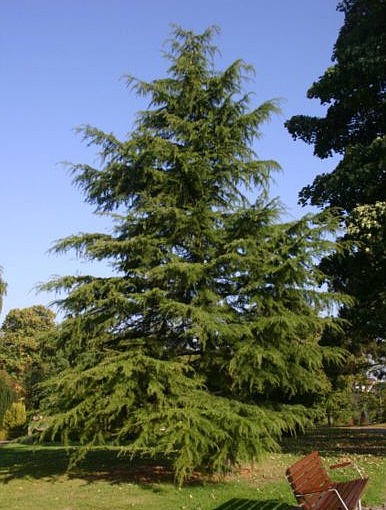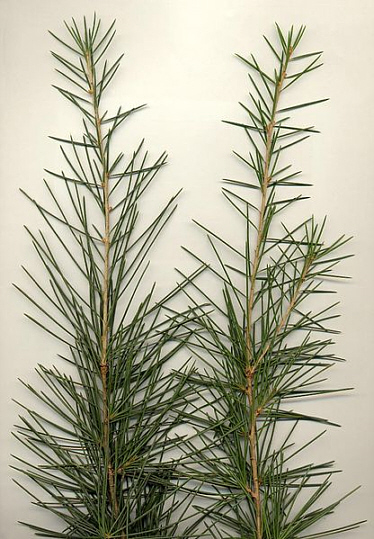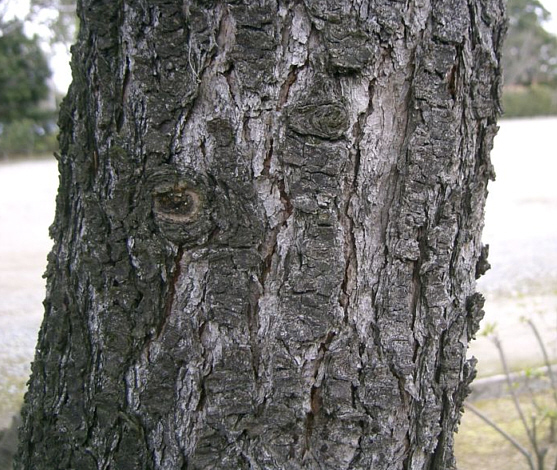

Zitierweise / cite as:
Carakasaṃhitā: Ausgewählte Texte aus der Carakasaṃhitā / übersetzt und erläutert von Alois Payer <1944 - >. -- Anhang A: Pflanzenbeschreibungen. -- Cedrus deodara (Roxb.) G. Don. -- Fassung vom 2007-06-27. -- URL: http://www.payer.de/ayurveda/pflanzen/cedrus_deodara.htm
Erstmals publiziert: 2007-06-27
Überarbeitungen:
Anlass: Lehrveranstaltung SS 2007
©opyright: Dieser Text steht der Allgemeinheit zur Verfügung. Eine Verwertung in Publikationen, die über übliche Zitate hinausgeht, bedarf der ausdrücklichen Genehmigung des Verfassers
Dieser Text ist Teil der Abteilung Sanskrit von Tüpfli's Global Village Library
WARNUNG: dies ist der Versuch einer
Übersetzung und Interpretation eines altindischen Textes. Es ist keine
medizinische Anleitung. Vor dem Gebrauch aller hier genannten Heilmittel wird
darum ausdrücklich gewarnt. Nur ein erfahrener, gut ausgebildeter ayurvedischer
Arzt kann Verschreibungen und Behandlungen machen!
Falls Sie die diakritischen Zeichen nicht dargestellt bekommen, installieren Sie eine Schrift mit Diakritika wie z.B. Tahoma.
Verwendete und zitierte Werke siehe: http://www.payer.de/ayurveda/caraka0001.htm

Abb.: Cedrus deodara (Roxb.) G. Don -
Himalayazeder
[Bildquelle: Wikipedia]

Abb.: Cedrus deodara (Roxb.) G. Don -
Himalayazeder, Tiebe
[Bildquelle: Wikipedia]

Abb.: Cedrus deodara (Roxb.) G. Don -
Himalayazeder, Borke
[Bildquelle: Wikipedia]
Drury:
"Pinus Deodara (Roxb.) N. O. Coniferae.
- Deodar Pine, Eng.
Description.—Large tree, coma pyramidal, large, branches verticillate, lower ones somewhat hanging down, upper ones spreading, all pendulous at the apex ; leaves spreading or pendulous at the top of the shortened branchlets, somewhat 30-fusciculately collected, shortish, straight, stiffish, somewhat quadrangular, sides slightly compressed, green, bluntishly mucronate at the apex; male aments solitary, erect, oblong, acute ; antheriferous bracts stalked, ovate above, rounded and denticulate at the apex ; cones solitary, erect on a short branchlet or on a 2-cleft branchlet twin, oval or oval-oblong, very obtuse, not umbilicate ; scales numerous, imbricated, somewhat woody ; bracts small, much shorter than the scale ; nuts obovate, narrowed at the base, shorter than the obovate-triangular wing.—Roxb. Fl. Ind. iii. p. 651.—Dec. Prod. xvi. s. post, p. 408.—Cedrus deodara, Loudon (cum. fig.)— Abies deodara, Lindl.-------Himalaya.
Medical Uses.—This species of pine yields a coarse fluid kind of turpentine (Kelon ka tel, Hind.), esteemed by the natives as an application to ulcers and skin diseases, as well as in the treatment of leprosy. Dr Gibson regards it as very effectual in this latter disease when given in large doses. It always acts as a diaphoretic, but is found very variable in its action,—in some cases a drachm causing vomiting; in others half an ounce inducing only slight nausea.—(Johnst. in Calc. Med. Phys. Trans., i. 41.) Dr Royle states that the leaves and twigs of the deodar are brought down to the plains, being much employed in native medicine.
Another species is the P. longifolia (Roxb.), which grows at elevations on the Himalaya from 2000 to 6000 feet. It is known by the native names Cheersullah, Sarul, and Thansa. The natives of Upper India obtain from it both tar and turpentine. The former is said to be equal to that obtained by a more refined process in Europe, and the turpentine is stated merely to require attention to render it equal to the -imported article.—(Journ. As. Soc. Beng, ii. 249). Dr Cleghorn has furnished some valuable remarks on the manufacture of tar from this tree as well as from P. excelsa. He considers it fully equal to Swedish tar.—Agri. Hort. Soc. of India, 1865, xiv p. i. App. p. 7.
Economic Uses.—The Deodar pine is highly valued for its timber, large quantities of which are annually felled for the railways and government purposes. Large forests of it exist on the Himalaya slopes, and especially in the Punjaub, along the banks of the Ravee, Beas, and other rivers. In the Chenab forests, too, they are plentiful. The P. excelsa, a tree in nowise inferior to the Deodar, grows in the. same regions. The range within which the Deodar is found growing spontaneously extends from about 3000 to 9000 feet above the sea, though it rarely occurs so low as 3000 feet, and grows at a disadvantage at the highest elevation. Previous to the establishment of the Forest Conservancy, vast quantities of these valuable timber-trees were recklessly destroyed, and it has been found desirable to form plantations for fresh plants, which, in the Punjaub especially, have been carried out on a large scale. According to the Conservator's report (Feb. 1867) on the forests of the Chenab and Ravee divisions, there were only remaining of first-class deodars 17,500— viz., 12,000 in Chenab, and 5500 in the Ravee division. This diminution of the numbers formerly known to exist caused the Government to limit the number to be felled annually, and rules for this object are now strictly observed. Prices for good Deodar in the Punjaub, increasing in the case of logs under 20 feet in length, averaged from about eight annas in 1850 to one rupee per cubic foot in 1866. For the greater lengths, from 20 to 30 feet, which are very scarce, the rate of eleven annas has now risen at Lahore to Rs. 2, 8; at Attock the price is one rupee per cubic foot.-Govt. Reports, July 1866.
In Joonsar Bawur, situated between the native states under the Simla agency and the Rajah of Gurwhal's country, there are several line Deodar forests which were inspected by Dr Brandis in 1863, and reported upon by him. He found one beautiful forest of pure Deodar, which seemed to spring up with great vigour wherever it had a chance, and thousands upon thousands of young seedlings coming up as thick as corn in a field. In the Kotee forest the Deodar growth was perfectly extraordinary. Two of the old stumps, which were of huge size, though imperfect, showed that the trees in the twenty-one years of their life had attained a diameter of timber of 12 and 13 inches respectively. In another forest, in Lokan, there were counted in one spot, in about 4 acres, between 200 and 250 first-class trees of 6 feet girth, none of them under 100 feet in height, while many must have approached 200 feet. The estimated contents of these nine forests of Joonsar Bawur were 34,000 first-class and 37,000 second-class Deodars. The above will give some idea of the resources of these forests. These are exclusive of the P. excelaa (Cheel), which also abounds there, and the Cheer or P. longifolia. In Major Pearson's report upon the localities at the head of the Jumna river he states—"It would be difficult adequately to describe the enormous seas of Cheer forest which line-its banks. The trees must be numbered by hundreds of thousands, many of them of a huge size. The same exists on the left bank of the Tonse, but higher up the river the Cheel (P. excelsa) takes the place of the Cheer, but the latter may be considered the chief 'tree. I believe, from inquiries, that if 15,000 or 20,000 logs can be got down to the river, there would be no difficulty in sawing up a lakh of sleepers per annum in these forests."—(Major Pearson's Report to Secy, to Govt., 5th Dec. 1869.) It may be interesting to mention hero that the first conifer found in Southern India (Podocarpus) was discovered by Major Beddome in 1870 abundant on the Tinnevelly Hills."
[Quelle: Drury, Heber <1819 - 1872>: The useful plants of India : with notices of their chief value in commerce, medicine, and the arts. -- 2d ed. with additions and corrections. London : Allen, 1873. -- xvi, 512 p. ; 22 cm. -- s.v.]
Dutt:
"CEDRUS DEODARA, Loud. Pinus Deodara, Roxb.
Sans, Devadāru. Vern. Deodār, Hind.
The aromatic wood of this elegant pine is considered carminative, diaphoretic, diuretic and useful in fever, flatulence, inflammation, dropsy, urinary diseases, etc. It is chiefly used in combination with other medicines. The following is an example of a diuretic mixture containing this drug. Take of devadāru wood, root of Moringa pterygosperma (sigru) and Achyranthes aspera (apāmārga), one drachm each and reduce to a paste with cow's urine. This composition is given in ascites."
[Quelle: Dutt, Uday Chand: The materia medica of the Hindus / Uday Chand Dutt. With a glossary of Indian plants by George King. -- 2. ed. with additions and alterations / by Binod Lall Sen & Ashutosh Sen. -- Calcutta, 1900. - XVIII, 356 S. -- S. 247.]